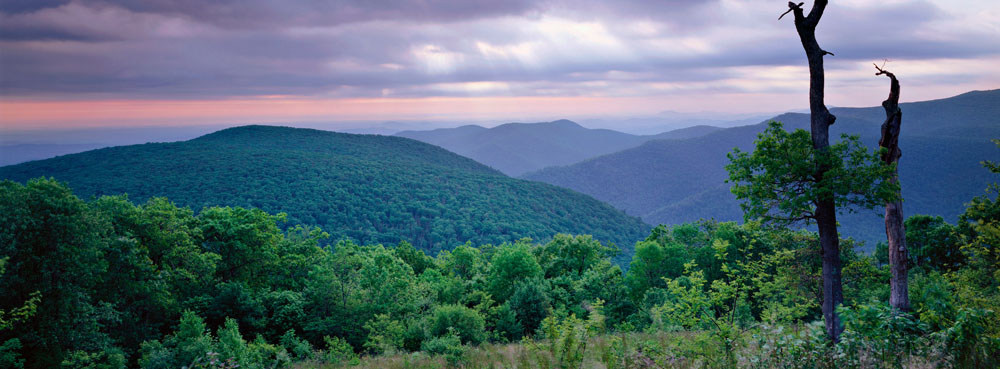The melodious Native American name Shenandoah evokes a sad song and the strife of the Civil War – the Shenandoah Valley was where the Confederate General ‘Stonewall’ Jackson launched his campaign. Today it is an area of outstanding natural beauty and a national park. The American writer Washington Irving, who died in 1859, described the Shenandoah Valley as ‘equal to the promised land in fertility and far superior to it for beauty’. Yet just five years after Irving’s death a local farmer deemed it ‘a desert’.
In the interim, the most beautiful valley in Virginia had become the focus of some of the fiercest fighting of the American Civil War, which culminated in ‘the Burning’ of 1864, when General Philip Sheridan and the Federal (Union) Army laid waste to the valley, leaving it a smouldering wilderness.
Shenandoah (meaning ‘daughter of the stars’) was the name the American Indians gave to the river that flows along the bottom of the valley. In fact, there are two rivers, the North Fork and South Fork, which flow on either side of Massanutten Mountain before converging at the town of Front Royal. They continue as one for some 50 miles (80km) across the border into West Virginia, then join the Potomac River at Harpers Ferry.
From the misty heights of the Blue Ridge Mountains, there are breathtaking vistas over the lazy loops of the Shenandoah’s South Fork, nonetheless, it is the North Fork, twisting like a serpent as it approaches Front Royal, that is traditionally regarded as the ‘rolling river’ of the famous sea shanty.

Shenandoah Valley is 150 miles (240km) long and an average of 25 miles (40km) wide. More than a century elapsed between the arrival of white settlers in Virginia in 1607 and their discovery of this region. In 1716, an expedition across the Blue Ridge Mountains under the leadership of Alexander Spottiswood, the Governor of Virginia (who drank a toast in champagne and claret to the party’s good fortune in uncovering an area of such beauty), opened the way for white settlement.
Until that time, the valley had been the domain of the Shawnee and Iroquois Native American peoples (the word Shenandoah is believed to derive from their language). The trail that they created along the bottom of the valley became a major route for further expansion westwards and is today an interstate highway.
The settlers who were attracted to the valley itself from the late 1720s onwards were of three racial origins but came from two main areas; most were German Lutherans and Scottish-Irish Presbyterians from Pennsylvania, and there was a trickle of English from eastern Virgin. What they all had in common was their reliance on the family unit as a workforce (there was almost no slavery in the Shenandoah Valley) and their dedication to an agricultural way of life – the fertile soil was suitable for dairy and livestock farming, and for growing both fruit and grain.
The valley’s natural advantages made it an obvious location for the Confederate Army under General Thomas J. ‘Stonewall’ Jackson – a Virginian himself – to shelter during the Civil War (1861-65). Its soil provided all the food the soldiers needed (indeed they called the valley their breadbasket); the old Indian trails along its floor offered an ideal means of moving troops and supplies quickly and in secret; and the whole valley, sheltered by the Shenandoah and Allegheny Mountains to the west and the Blue Ridge Mountains to the east, was easily defended.
In addition, whoever held the valley one of the few viable north-south highways. Having suffered several crushing defeats in the Shenandoah Valley in 1862, and dismayed at renewed fighting in the area, on 29th September 1864, Sheridan ordered his cavalry to burn anything that might be of use to the Confederates. His troops took him at his word: crops, mills and granaries, farms livestock and homes were all set ablaze.
It must have seemed to the survivors of the war that the valley would never bloom again. But the healing forces of nature, combined with the perseverance and hard work of local people, in time re-created the landscape. Today, the valley’s orchards provide more than half of Virginia’s apples, its pastures produce all the state’s poultry and the majority of its beef and vegetables, and its vineyards yield many fine vines.
Most of the trees in the valley have become re-established. The only exception is the chestnut, which recovered from the war, but was ravaged by blight at the turn of the century. Even today, new shoots on the trees are struck by the disease. As a result, the forest comprises chiefly oak, white pine, willow and sycamore trees.
The 105 mile (169km) long mountain-top Skyline Drive affords spectacular views over the Shenandoah Valley. There are now more than 700 plant species here, including trees, shrubs, vines and as many as 80 different wild flowers that provide food and shelter for up to 200 varieties of birds.

Established in 1935, the Shenandoah National Park now encompasses almost 200,000 acres (80,000 hectares) of the Shenandoah Valley and its surrounds. In addition to woodlands and meadows, the park also includes some 60 peaks rising more than 2000ft (600m) in height, and every year thousands of visitors flock here to enjoy its spectacular scenery, only 75 miles (120km) from the nation’s capital city, Washington D.C.

The garden of Virginia, Shenandoah possesses many of nature’s bounties and it is a cradle of history. But, above all, it is proof of the power of nature which, in less than 150 years, has restored what was ravaged so thoroughly.

-end-




































